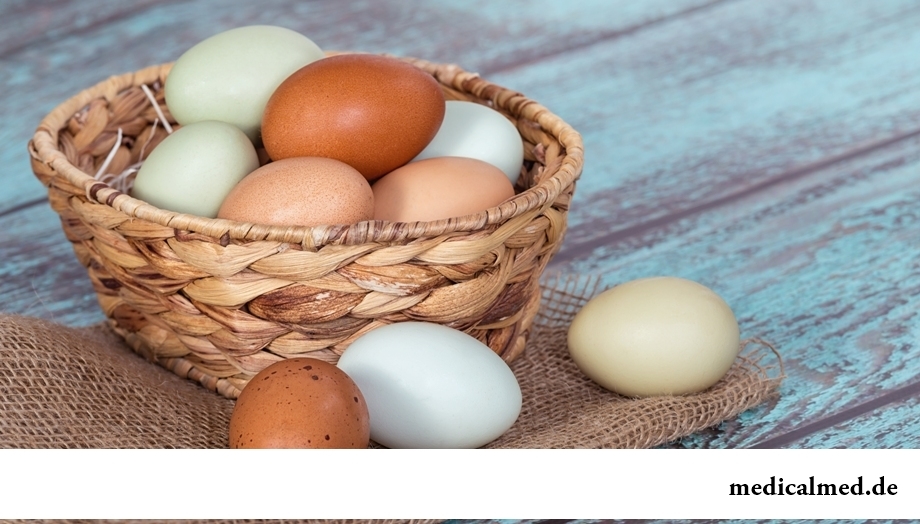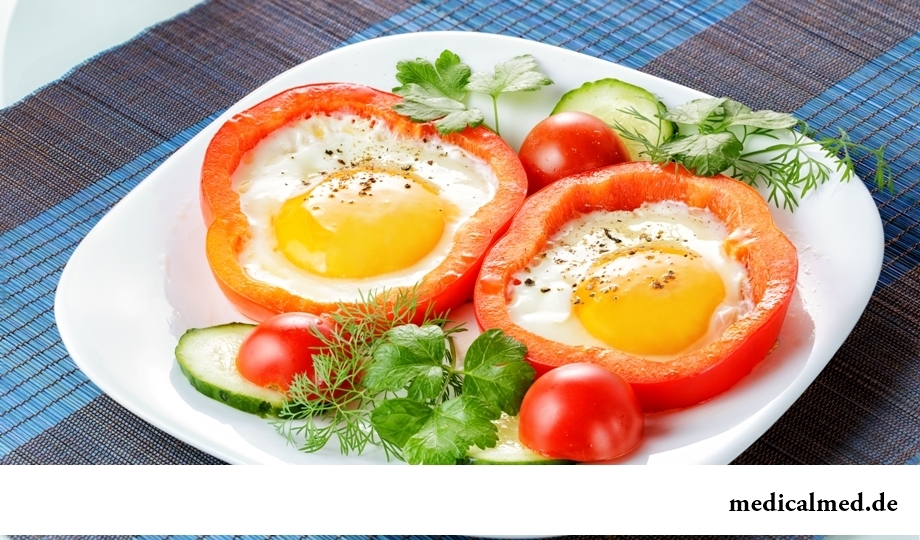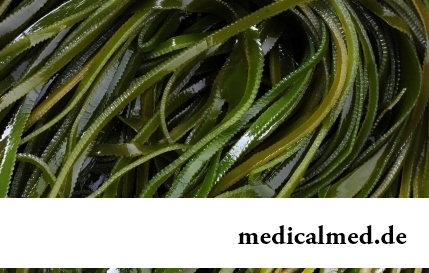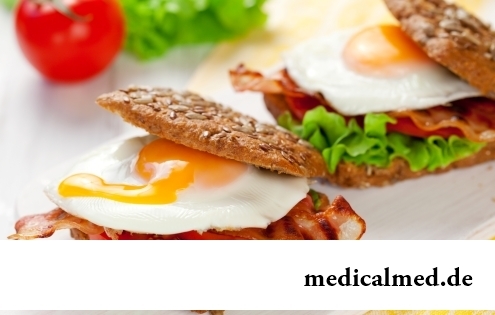





Egg
Already for many thousands of years eggs enter a diet of the person. Nevertheless, disputes between doctors and nutritionists concerning advantage and harm of eggs do not stop to this day.

Description
Egg represents the food stuff of an asymmetric and oval form from above covered with a shell under which there is an egg white and yolk inside. Receive this product from various breeds of domestic hens owing to their reproductive ability.
People began to breed hens about 10 thousand years ago, presumably in Southeast Asia and China. At first the dzhunglevy hens belonging to family of Fazanov who and now it is possible to meet in the territory of these countries were cultivated.
Now in addition to farms, poultry farms from around the world are engaged in production of eggs. According to preferences, in a number of the countries prefer to part the breeds of hens laying white and light yellow eggs (in America and Russia they are considered better), or brown (in Great Britain). Actually flavoring and nutritious properties of white and brown eggs identical and their only difference consists that the brown shell is a little stronger and thicker therefore they are more suitable for transportation.
Color of a yolk is influenced by a forage which chicken eats. The more in a stern of carotinoids (a natural pigment of red and yellow color), the nasyshchenny there will be a color of a yolk. Carotinoids contain in a lucerne, corn and other plants with which traditionally feed hens. For this reason home-made eggs have the yolk which was more sated on color more often. But the light yolk does not speak about bad quality of egg but only that the forage which chicken ate contained few carotinoids.
During receipt of eggs in sale they are marked depending on category and an admissible period of storage. Marking, however, is present only at products from poultry farms, and the home-made eggs selling in the market are free from all classifications. The buyer buys this product at own risk. Marking consists of letters and figures in which information on weight and age of a product disappears. So, for example, the letter "D" says that egg dietary, and a letter "C" - that egg table. The letter "B" means that egg of the highest category and weighs more than 75 g, "About" - selected eggs weighing 65-75 g, figure "1" costs on eggs of the first category weighing 55-65 g, "2" - the second category weighing 45-55 g, "3" - on eggs of the third category weighing 35-45 g. Table eggs of the second category, that is "C2" are the most widespread.
Use in cookery
Culinary opportunities of eggs surpass many food stuffs. They are baked in an oven, cooked hard-boiled or soft-boiled, do omelets and fried eggs, salted, pickled, added to cocktails, pastries, salads, toasts, cutlets. In many products from the test of egg are indispensable ingredient without which magnificent and tasty confectionery will not turn out.
Freshness of eggs can be defined in several ways. In cookery use as fresh eggs, and 2-3-hnedelnoy prescription. On condition of the correct storage (7-13 degrees) it is possible not to be afraid that eggs will lose the nutritious properties. Fresh eggs perfectly will be suitable for preparation of a pashot and fried eggs. But if to hard-boil fresh eggs, they are badly cleaned therefore for preparation of salads and other dishes with boiled eggs it is better to use a product which some time already lay down in the refrigerator. In sauces, omelets, baked puddings, the test and other dishes where outward is not important, the period of storage does not play a special role (naturally, within limits).
Structure and caloric content of eggs
In 100 g of egg 76,15 g of water, 12,56 g of proteins, 9,51 g of fats, 2,5 g of cellulose, 1,06 g of ashes, 0,72 g of carbohydrates contain; vitamins: Retinolum (A), thiamin (B1), Riboflavinum (B2), Niacinum (PP or B3), sincaline (B4), pantothenic acid (B5), pyridoxine (B6), folic acid (B9), cyanocobalamine (B12), ascorbic acid (C), alpha tocopherol (E), calciferol (D), phylloquinone (K); macrocells: phosphorus, sodium, magnesium, potassium, calcium; microelements: fluorine, zinc, selenium, copper, manganese, iron.
Caloric content of egg makes about 143 kcal on 100 g of a product.
Advantage of eggs
Egg contains more than hundred useful substances so the main advantage of eggs consists that they can be used as usual food or for clinical nutrition. Ovalbumin is the most valuable and effective type of protein which is used by an organism for "construction" of muscles. Even in milk and beef there is no so much nutritious enzyme how many in egg.
In egg practically all table of Mendeleyev is submitted, besides, it almost completely (for 97%) is acquired by an organism and does not give slags.
Also the advantage of egg consists that at its structure there are polyunsaturated fatty acids playing an important role for prevention of nervous and cardiovascular diseases, and also the selenium and carotene rendering the antioxidant properties improving a condition of skin, the warning oncological diseases adjusting work of reproductive system.

Niacinum necessary for formation of sex hormones and food of a brain is a part of eggs. And the yolk contains vitamin D which promotes digestion of calcium an organism and to strengthening of a bone tissue. Letsiin improves memory, is useful to a liver and increases mental capacities. Luteinum which is contained in a yolk helps to avoid problems with sight, and sincaline promotes prevention of oncological diseases.
Not only eggs, but also egg shell as at its structure there is a large number micro and macrocells among which first place is won by calcium are useful.
Harm of eggs
As a part of eggs there are saturated fats therefore their regular use leads to increase in cholesterol blood. And if to be fond of eating of crude eggs, then there is a risk to catch a salmonellosis.
Eggs can render harm also on children and to become the reason of emergence at them of an allergy therefore it is necessary to limit their quantity in a diet.
Our kidneys are capable to clear three liters of blood in one minute.

The pine is one of the most widespread plants of our woods. Its needles and pitch not without reason called by "gallipot", since ancient times испол...
Section: Articles about health
Producers of milk mixes for children assure: mixes are ideally balanced and adapted for needs of babies. If mother should raise artificially the kid owing to serious problems with health, to do nothing – m substitutes...
Section: Articles about health
The naturopathy sometimes moves as the new direction of medicine, something like fashionable hobby, and there is nothing farther from the truth. This most ancient direction, the word "naturopathy" is translated as "treatment by the nature", and, no doubt, treatment by natural gifts was the first and only, available to the person in ancient times. Despite modern achievements of medicine, the naturopathy remains urgent and today, anyway the person - a part of the nature, and природн...
Section: Articles about health
More than a half of the married couples which faced prostatitis – leave. The new broadcast "Female View of Prostatitis" will help to learn...
Section: Articles about health
The number of long-livers is very small. One person from 5 thousand lives up to age of 90 years, and the centenary boundary steps over only one of 20 thousand. However, doctors claim that each of us is quite able to affect own destiny. At the same time speech to Ida...
Section: Articles about health
For residents of the countries of Southeast Asia various algas are an obligatory component of a daily diet. Their popularity is connected not only with high tastes, but also with numerous curative properties. Russians are a little familiar with products such that is distressing: algas are so useful that they should be eaten as often as possible. Let's get acquainted closer with useful properties of this seafood....
Section: Articles about health
The medicine promptly develops, and the fact that else quite recently it seemed by miracle can now. We are not surprised any more to the fact that sport...
Section: Articles about health
Good appetite was always considered as a sign of good health. The correct operation of the mechanism which is responsible for the need for nutrients and receiving pleasure from process of its satisfaction demonstrates that the organism functions without special from...
Section: Articles about health
Each woman has preferences in the field of use of those goods which help us to look good, feel young and effective. Besides: selection process of favourite perfume, shampoo or decorative cosmetics already lightens the mood and serves as a peculiar stress medicine. Happens very offensively when the acquired perfumery and cosmetic products not only do not meet our expectations, but also becomes the reason of problems with health. Sources неприятн...
Section: Articles about health
Work of a brain is extremely complex and in many respects is not studied yet. It is confirmed also by the features of thought processes which are shown in...
Section: Articles about health
Zone hypostases under eyes - very widespread problem giving to people is a lot of inconvenience. Hypodermic fabric in these parts has very loose structure and almost does not contain collagenic fibers. Besides, the skin covering подглазья constantly is exposed...
Section: Articles about health
The name of this disease precisely reflects the problem reason: it consists in the bra fastener pressure upon a certain zone of a back. At the same time one of vertebrae of chest department of a backbone is as if blocked and loses mobility, and the loading falling on it is distributed on the next vertebrae. At 70-80% of women local pains in a backbone point on which the fastener of the often put most on bra presses result....
Section: Articles about health
All are familiar with cold, and practically everyone believes that he has sufficient knowledge and experience that correctly to treat it. N...
Section: Articles about health
Statistically, pathologies of a thyroid gland in the world more than 500 million people have. Failures in work of this body lead to heavy disbolism, development of heart diseases, vessels, a reproductive and nervous system. In hard cases excessive...
Section: Articles about health
(Xerostomia) many people consider feeling of a xerostomia small and easily removable inconvenience. This delusion: the symptom can demonstrate existence of serious diseases. It is worth to remember also that saliva performs important functions in an organism: clears the surface of teeth of a food plaque, growth of pathogenic microorganisms oppresses, normalizes acid-base balance, liquefies food and helps to split the carbohydrates which are contained in it. Chronic deficit слюн...
Section: Articles about health
The dietology, as well as other sciences, does not stand still. Food stuffs are exposed to comprehensive study, and scientists receive new and...
Section: Articles about health
The nature does not stand stagnation and monotony. It is known that tissues of a human body atrophy if do not receive necessary loadings. It fully belongs also to a cerebral cortex: when it is not given full-time job, it begins to function worse. In резуль...
Section: Articles about health
The phenomenon of improvement of a condition of the patients at administration of drugs who are not containing active agents, so-called effect of placebo is known long ago. At the end of the 18th century the American doctor Perkins began to treat people the "miracle" sticks made of alloy of steel and brass. Was for several minutes to press such subject enough to a sore point that it became much easier for the patient. Having suspected Perkins of charlatanism, his colleagues tried to repeat "miracle" by means of sticks, steles...
Section: Articles about health
Life does not indulge the modern woman special emotional comfort and carelessness. Fatigue, troubles at work, misunderstanding...
Section: Articles about health
Striya (extension) are the defects of skin having an appearance of direct or wavy strips from 1 to 10 cm long and 1-5 mm wide. In most cases at women of a striya are located on a stomach, hips, a breast or buttocks. At athletes they can appear on shoulders and внутренн...
Section: Articles about health
Memory is an ability of the central nervous system to fix, keep and as necessary to reproduce information on knowledge or skills received by the person or an animal during life. The mechanism of this process is up to the end not studied....
Section: Articles about health
Statistically, in Russia about 34% of citizens smoke. Most of consumers of tobacco has problems about health sooner or later...
Section: Articles about health
A lot of things depend on a condition of a backbone in a human body, a backbone - not only a support for a body, it also a receptacle for a spinal cord, that is why malfunctions with a backbone are so dangerous. To treat rachis diseases very difficult and long...
Section: Articles about health
The words "disease" and "patient" not without reason come from one root – "pain". As a rule, symptoms of illnesses thoroughly spoil to patients life. However from this rule there are exceptions. Some diseases are shown by signs which can cause even positive emotions. It is a pity only that the majority of such illnesses are heavy and incurable....
Section: Articles about health
Cystitis, or inflammation of a mucous membrane of a bladder, this very widespread disease, which, owing to some persons...
Section: Articles about health
Childbirth is the most important event in life of each woman. We are women we give birth to the new little man on this light. Now the tendency to that was outlined, as men want to participate in labor too. But there is a question and whether it is worth allowing the husband...
Section: Articles about health
Osteoporosis this general disease which main sign is decrease in density of a bone tissue. On distribution width it takes the fourth place among noninfectious diseases. The illness develops at mature age more often: in our country about a third of women and a quarter of men suffers from it 50 years are more senior....
Section: Articles about health
